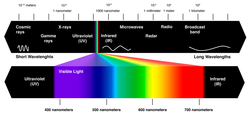
Light is all around us - lets us see things but is still somewhat of a mystery. Is light a wave or a particle? Both as it turns out. Light behaves as a wave but has particle-like features as well (as in "pressure"). Wavelength determines the type of light such as - radio waves (longest) to gamma rays (shortest). What we see as visible light is just a very small part of a set of millions of frequencies called "color." Visible light can be broken down and studied. That's called spectroscopy - or the way light is filtered through a prism or a plastic "diffraction grading" and analyzed. That's how astronomers can figure out what stars; planetary atmospheres; comets and other celestial objects are made of.
Binary star systems are two stars that orbit each other. Most stars in the Universe are part of a "multiple star system" - meaning two or more. Astronomers know this by breaking down the light sources (spectroscopy) from what looks like a single star - even in a powerful telescope.
Planets around multiple star systems (click for the youtube video) are now thought to be more prevalent than single star systems like our Sun (or "Sol"). So a "Star Wars" Universe and the fictional planet "Tatooine" with two suns setting is now way more likely. Wait for NASA's Kepler Spacecraft to see how many Earth-like planets are out there.
Binary star systems are two stars that orbit each other. Most stars in the Universe are part of a "multiple star system" - meaning two or more. Astronomers know this by breaking down the light sources (spectroscopy) from what looks like a single star - even in a powerful telescope.
Planets around multiple star systems (click for the youtube video) are now thought to be more prevalent than single star systems like our Sun (or "Sol"). So a "Star Wars" Universe and the fictional planet "Tatooine" with two suns setting is now way more likely. Wait for NASA's Kepler Spacecraft to see how many Earth-like planets are out there.
 RSS Feed
RSS Feed
